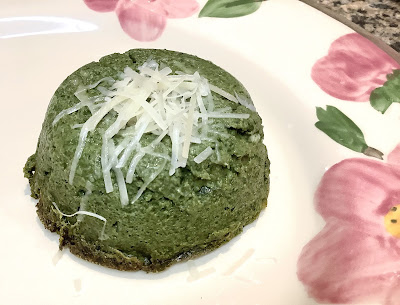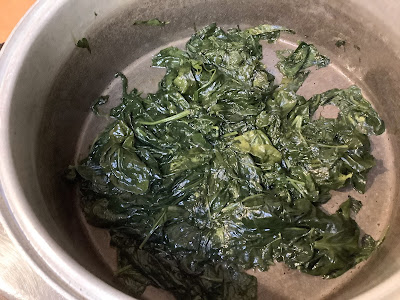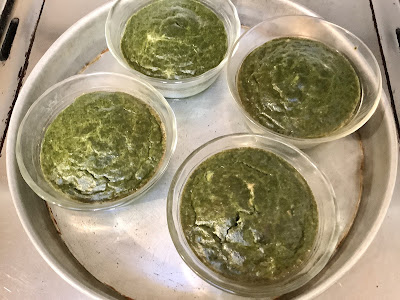
Recipe: Simple spinach timbales make a delicious side dish
 |
|
Spinach timbale is an easy and delicious side dish.
(Photos: Debbie Arrington)
|
Timbales sound fancy (and some are). This simple version shows off one of our favorite spring vegetables – spinach.
We love our spinach on the Left Coast. Jeanne Voltz (a.k.a. Marian Manners), the Los Angeles Times food editor and columnist during the 1950s and '60s, noted that this leafy green was popular with both home cooks and chefs.
“Californians eat spinach with no prodding at all,” she wrote in “The California Cookbook,” a 1970 compilation of Golden State favorites. “The most deluxe restaurants serve enormous quantities of creamed spinach.”
This recipe is a modified version of a throwback. Along with several other spinach recipes, Spinach Timbales were featured as an alternative to ubiquitous creamed spinach in the 1949 “Sunset Cook Book of Favorite Recipes.” (I’ll save that book’s Taxco Spinach-Stuffed Pancakes for another day.)
Timbales got their French name from their shape; it’s derived from the French word for “kettledrum.” Custard cups or other similarly shaped molds work great.
Timbales may have crusts that act as the mold for the rich ingredients inside. The most simple (such as this) are crustless egg custards blended with other ingredients and steamed or baked in a water bath.
Before puréeing, cook your spinach with as little water as possible.
 |
|
Sautéeing the spinach in a little olive
oil is one way to cook it with little water.
|
Spinach timbales
Makes 4 servings
Ingredients:
1 cup cooked spinach, puréed
2 eggs, beaten
½ cup cream
1 scallion, finely chopped (including some green leaves)
¼ cup Parmesan cheese, shredded
1/8 teaspoon hot pepper sauce
1/8 teaspoon pepper
1/8 teaspoon mace or nutmeg
Butter, margarine or non-stick spray
Instructions:
Butter or grease 4 molds or custard cups. Set aside.
Preheat oven to 350 degrees F.
Bring 2 cups water to boil, then turn off heat.
In a mixing bowl, combine puréed spinach, eggs, cream, scallion, Parmesan cheese, hot sauce, pepper and mace or nutmeg until blended. Spoon mixture into prepared molds or custard cups.
Place filled molds or cups in a deep-dish pie pan (or similar pan) and place pan on oven shelf. Carefully fill pan halfway with hot water around the molds or cups (it may not take all 2 cups).
Bake at 350 degrees until the timbales are set and, when tested, a thin-bladed knife comes out clean, about 35 to 40 minutes. Let rest 5 minutes.
To unmold, run a thin-bladed knife along the inside of the mold or cup. Carefully invert over plate.

Comments
0 comments have been posted.Sacramento Digs Gardening to your inbox.
Sites We Like
Garden Checklist for week of May 5
Survey your garden after the May 4 rainstorm. Heavy rain and gusty winds can break the neck of large flowers such as roses. Also:
* Keep an eye on new transplants or seedlings; they could take a pounding from the rain.
* Watch out for powdery mildew. Warmth following moist conditions can cause this fungal disease to “bloom,” too. If you see a leaf that looks like it’s dusted with powdered sugar, snip it off.
* After the storm, start setting out tomato transplants, but wait on the peppers and eggplants (they want warmer nights). Pinch off any flowers on new transplants to make them concentrate on establishing roots instead of setting premature fruit.
* Trim dead flowers but not leaves from spring-flowering bulbs such as daffodils and tulips. Those leaves gather energy to create next year's flowers. Also, give the bulbs a fertilizer boost after bloom.
* Pinch chrysanthemums back to 12 inches for fall flowers. Cut old stems to the ground.
* Mulch around plants to conserve moisture and control weeds.
* From seed, plant beans, beets, cantaloupes, carrots, corn, cucumbers, melons, pumpkins, radishes and squash.
* Plant onion sets.
* In the flower garden, plant seeds for asters, cosmos, celosia, marigolds, salvia, sunflowers and zinnias. Transplant petunias, zinnias, geraniums and other summer bloomers.
* Plant perennials and dahlia tubers for summer bloom.
* Don’t wait; plant summer bulbs, such as gladiolus and tuberous begonias.
* Harvest cabbage, lettuce, peas and green onions.